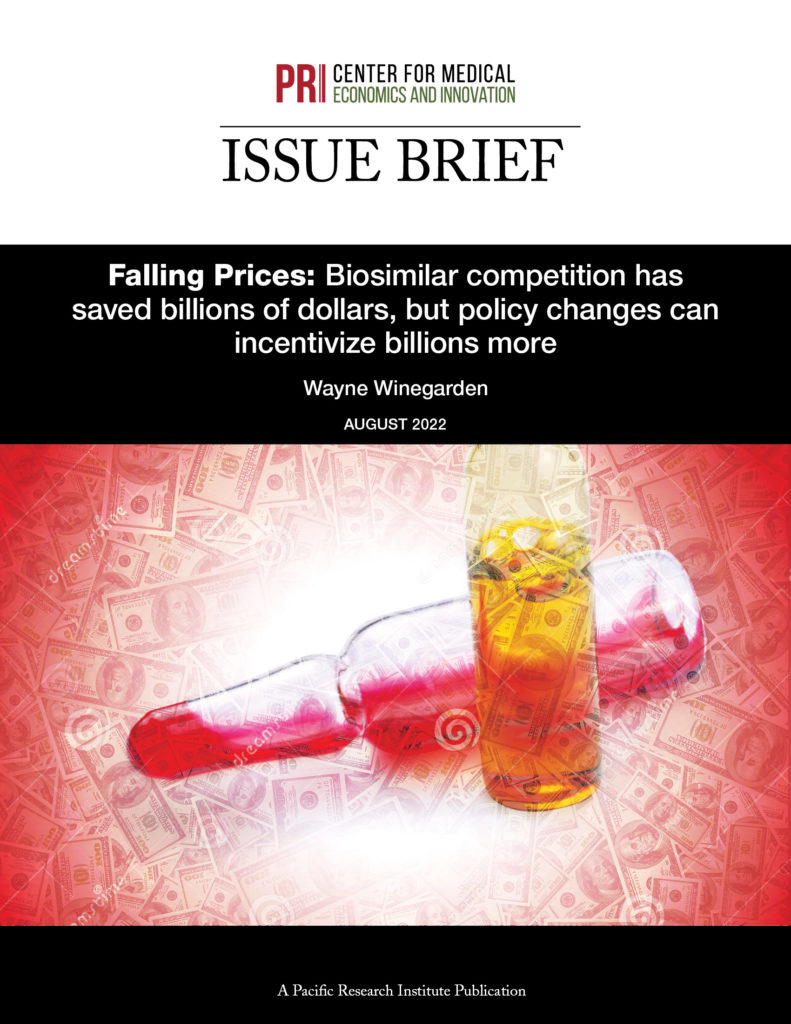NEW BRIEF: Biosimilars Save Patients Over $11 Billion Annually, Fixing Broken System Would Help Patients Save More
 SACRAMENTO – Biosimilars competition saves patients and the health care system over $11 billion annually and could generate even more savings if the broken drug pricing system were reformed, finds a new issue brief released today by the Center for Medical Economics and Innovation at the nonpartisan Pacific Research Institute.
SACRAMENTO – Biosimilars competition saves patients and the health care system over $11 billion annually and could generate even more savings if the broken drug pricing system were reformed, finds a new issue brief released today by the Center for Medical Economics and Innovation at the nonpartisan Pacific Research Institute.
“Patients living with cancer, autoimmune diseases, osteoporosis, and other illnesses are receiving revolutionary treatment from biologics,” said Dr. Wayne Winegarden, the Center director and the study’s author. “As our research shows, patients and the health care system are experiencing over $11 billion in savings today thanks to the introduction of biosimilars to the marketplace.”
Click here to read “Falling Prices”
Originator biologics create tremendous value for patients, but the process to develop new biologics is complex and expensive (costing near $2.9 billion each). Generally, developers will have 12 years of patent protection remaining to recoup their capital costs, after which competition enters the marketplace through biosimilars, which incentivizes significant savings.
As documented in PRI’s research, tens of billions in cost savings have been generated annually due to the introduction of biosimilar competition in seven drug classes:
- Originator biologic prices increased for all seven biologic drug classes in the eight quarters prior to the introduction of biosimilar competition, as high as 16.8 percent for Neulasta.
- Once biosimilar competition was introduced, the costs for originator biologics dropped for all seven biologic drug classes, as much as 55.6 percent for Remicade and 57.1 percent for Neulasta.
- Competition is saving patients $11.2 billion today relative to what they would have spent absent biosimilars.
As of the second quarter of 2022, biosimilars’ market share has risen for all seven classes since the fourth quarter of 2018, to 76.7 percent for Filgrastim and 70.9 percent for Bevacizumab.
Forthcoming biosimilars to Humira and Enbrel could generate $5.0 billion and $1.4 billion in savings respectively compared to current costs once the biosimilars gain 75 percent market share.
Flaws in the drug pricing system can block access to biosimilars. Pharmacy benefit managers often exclude biosimilars from drug formularies or put them at a disadvantage, hindering patient access to these lower-cost treatments. Thanks to the broken drug pricing system and a drug rebate system that benefits insurers and third parties rather than patients, “drug rebate walls” are a threat to biosimilar competition by tying volume to rebates.
“Patients should not lose out on significant savings from biosimilars due to a broken drug pricing system that often discourages competition and blocks patient access to lower-cost, life-saving treatments,” said Winegarden. “Policymakers should make it a priority to increase price transparency and reform drug rebates to benefit patients rather than insurers and intermediaries.”
The Pacific Research Institute (www.pacificresearch.org) champions freedom, opportunity, and personal responsibility through free-market policy ideas. Follow PRI on Facebook, Twitter, and LinkedIn.

